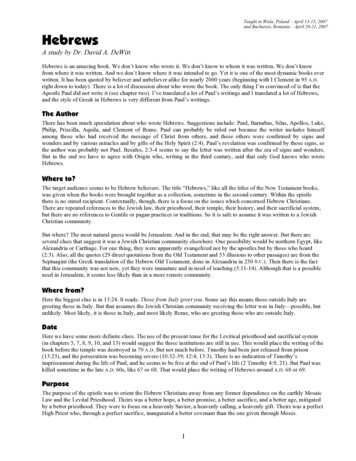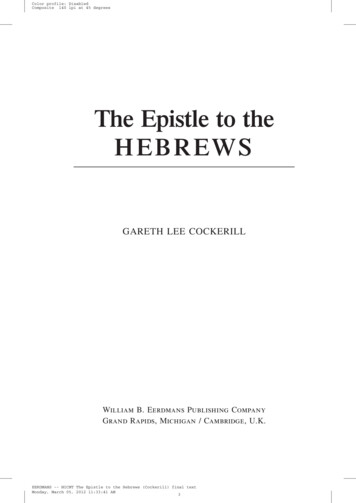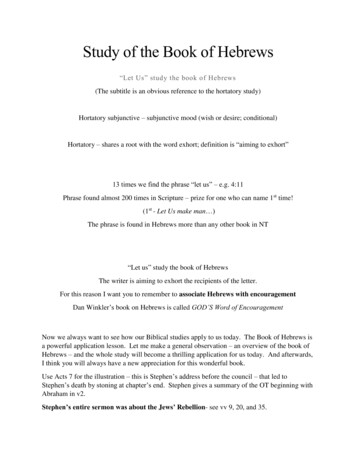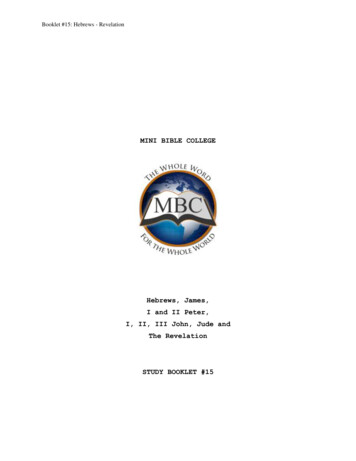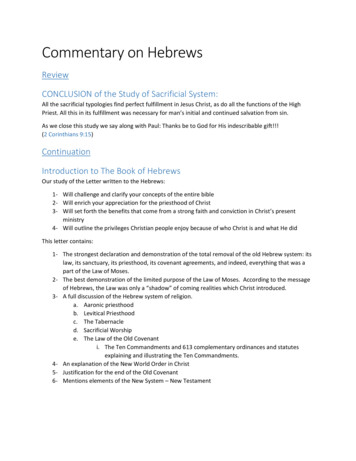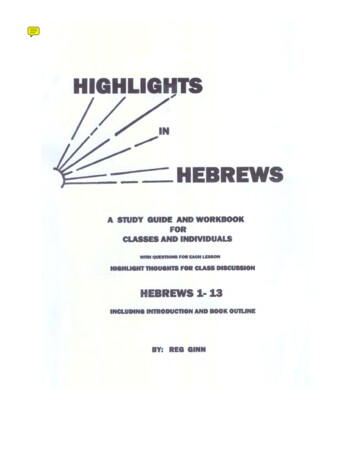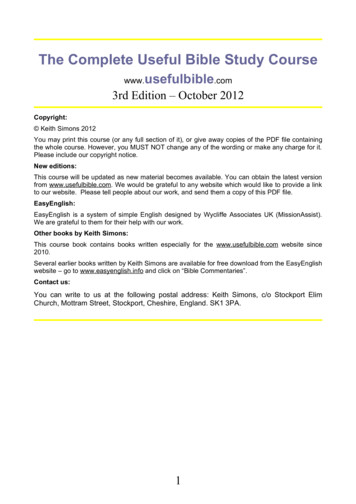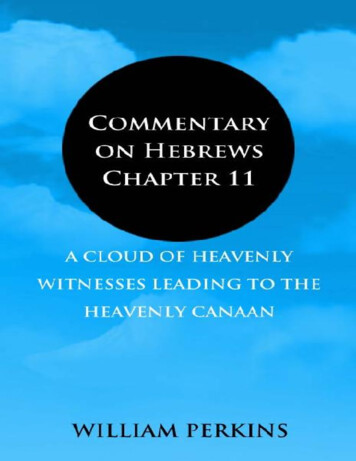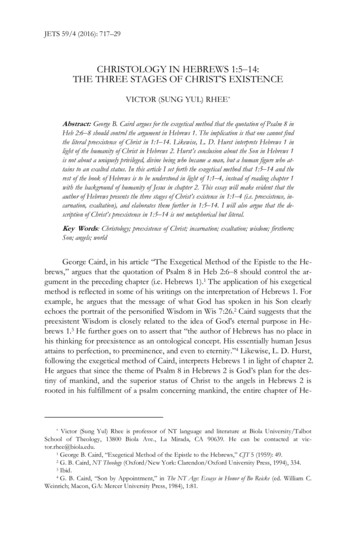
Transcription
JETS 59/4 (2016): 717–29CHRISTOLOGY IN HEBREWS 1:5‒14:THE THREE STAGES OF CHRIST’S EXISTENCEVICTOR (SUNG YUL) RHEE*Abstract: George B. Caird argues for the exegetical method that the quotation of Psalm 8 inHeb 2:6‒8 should control the argument in Hebrews 1. The implication is that one cannot findthe literal preexistence of Christ in 1:1‒14. Likewise, L. D. Hurst interprets Hebrews 1 inlight of the humanity of Christ in Hebrews 2. Hurst’s conclusion about the Son in Hebrews 1is not about a uniquely privileged, divine being who became a man, but a human figure who attains to an exalted status. In this article I set forth the exegetical method that 1:5‒14 and therest of the book of Hebrews is to be understood in light of 1:1‒4, instead of reading chapter 1with the background of humanity of Jesus in chapter 2. This essay will make evident that theauthor of Hebrews presents the three stages of Christ’s existence in 1:1‒4 (i.e. preexistence, incarnation, exaltation), and elaborates them further in 1:5‒14. I will also argue that the description of Christ’s preexistence in 1:5‒14 is not metaphorical but literal.Key Words: Christology; preexistence of Christ; incarnation; exaltation; wisdom; firstborn;Son; angels; worldGeorge Caird, in his article “The Exegetical Method of the Epistle to the Hebrews,” argues that the quotation of Psalm 8 in Heb 2:6‒8 should control the argument in the preceding chapter (i.e. Hebrews 1).1 The application of his exegeticalmethod is reflected in some of his writings on the interpretation of Hebrews 1. Forexample, he argues that the message of what God has spoken in his Son clearlyechoes the portrait of the personified Wisdom in Wis 7:26.2 Caird suggests that thepreexistent Wisdom is closely related to the idea of God's eternal purpose in Hebrews 1.3 He further goes on to assert that “the author of Hebrews has no place inhis thinking for preexistence as an ontological concept. His essentially human Jesusattains to perfection, to preeminence, and even to eternity.”4 Likewise, L. D. Hurst,following the exegetical method of Caird, interprets Hebrews 1 in light of chapter 2.He argues that since the theme of Psalm 8 in Hebrews 2 is God’s plan for the destiny of mankind, and the superior status of Christ to the angels in Hebrews 2 isrooted in his fulfillment of a psalm concerning mankind, the entire chapter of He-* Victor (Sung Yul) Rhee is professor of NT language and literature at Biola University/TalbotSchool of Theology, 13800 Biola Ave., La Mirada, CA 90639. He can be contacted at victor.rhee@biola.edu.1 George B. Caird, “Exegetical Method of the Epistle to the Hebrews,” CJT 5 (1959): 49.2 G. B. Caird, NT Theology (Oxford/New York: Clarendon/Oxford University Press, 1994), 334.3 Ibid.4 G. B. Caird, “Son by Appointment,” in The NT Age: Essays in Honor of Bo Reicke (ed. William C.Weinrich; Macon, GA: Mercer University Press, 1984), 1:81.
718JOURNAL OF THE EVANGELICAL THEOLOGICAL SOCIETYbrews 1 is related to the theme of mankind’s destiny.5 For this reason, Hurst’s conclusion of the Son in Heb 1:1‒14 is not about a uniquely privileged, divine beingwho became a man but a human figure who attains to an exalted status.6 Accordingto the exegetical method of Caird and Hurst, there is no room for the idea of Jesushaving been the literal preexistent Son before his incarnation in their interpretationof Hebrews 1.However, a careful study of Hebrews 1 reveals that the author of Hebrewsconsidered Jesus as the preexistent Son, not in a metaphorical but in a literal sense,before the stage of incarnation. In this article I intend to argue for the literal preexistence of Christ in Heb 1:5‒14. To accomplish this purpose, I will also discussother aspects of Christ’s existence. The Son’s three stages of existence, which arefirst introduced in the exordium (1:1‒4), are elaborated more fully in 1:5‒14, andfurther developed in other parts of Hebrews. 7 Here in 1:5‒14 the author intertwines another cycle of Christ’s existence in the following order: exaltation (v. 5),incarnation (v. 6), preexistence (vv. 7‒12), and exaltation (vv. 13‒14).8I. EXALTATION (1:5)In verse 5, the author elaborates the aspects of Christ’s exaltation by employing two OT quotations: Ps 2:7 and 2 Sam 7:14 (cf. 1 Chr 17:14). This verse introduces the question, “For to which of the angels did he ever say, ‘you are my Son;today I have begotten you’?” This OT quotation is taken from Ps 2:7, in which thepsalmist depicts the rebellion of the nations against God and his anointed. In theLXX, the plural form of the Hebrew word “( בני sons”) is at times translated as“angels” (ἄγγελοι), thus rendering the Hebrew phrase for “the sons of God” as“the angels of God” (e.g. Job 1:6; 2:1; 38:7). But the singular form of Hebrew word “( ֵבּן a son”) is never rendered as “an angel” (ἄγγελος) in the LXX. Neither thephrase for “an angel of God” nor “an angel of the Lord” in the Hebrew Bible isever translated as “a son of God” in the LXX. The author of Hebrews also reflectsthis understanding in 1:5 with the use of the singular form τίνι (“to which”). Therhetorical question “to which of the angels (τίνι τῶν ἀγγέλων) did he eversay ?” expects a negative answer; certainly, God never spoke to any one of theangels in the OT as he spoke to his Son in Ps 2:7.9 Moreover, this negative answeris reinforced by the second quotation (2 Sam 7:14 [cf. 1 Chr 17:14]), which is alsoconnected to the same verb εἶπεν (“he said”) by the adverb πάλιν (“again”). Both5 L. D. Hurst, “The Christology of Hebrews 1 and 2,” in The Glory of Christ in the NT: Studies in Christology in Memory of George Bradford Caird (ed. L. D. Hurst and N. T. Wright; Oxford: Clarendon, 1987),155‒57.6 Ibid., 163.7 For the relationship of Heb 1:1‒4 to 1:5‒14, and to the rest of Hebrews, see Paul Ellingworth, TheEpistle to the Hebrews: A Commentary on the Greek Text (NIGTC; Grand Rapids: Eerdmans, 1993), 90.8 According to Victor (Sung Yul) Rhee, these three stages of Christ’s existence are introduced in1:1‒4, and repeated in an inverted order in 1:5‒14 (“The Role of Chiasm for Understanding Christologyin Hebrews 1:1‒14,” JBL 131 [2012]: 341–62).9 Ibid., 360. For a similar line of argument see also Ellingworth, Epistle to the Hebrews, 111.
CHRISTOLOGY IN HEBREWS 1:5‒14719of the quotations answer the question, “to which of the angels did he ever say ?”Again, the implication is that God has not at any time addressed any one of the angels in sonship terms as he did his Son in Ps 2:7.10An important issue to consider in verse 5 is the meaning of the expression“Today, I have begotten (γεγέννηκα) you.” In what sense is the Son begotten?Another related question is, “When was the Son begotten?”11 An examination ofthe word γεννάω (“beget”) in the LXX and NT shows that the Father’s begettingthe Son in verse 5 is a metaphorical expression for the exaltation of Christ. In theLXX, the term γεννάω is used to refer primarily to giving birth to someone, but itsnon-literal usages are not lacking. The original context of Ps 2:7 shows that theexpression “I have begotten you” is used metaphorically to indicate the renewal ofthe relationship between God and the Davidic king on the day of coronation (i.e.the king becoming God’s son).12 In Prov 8:25, wisdom is said to have been begotten by God. In Isa 1:2, the word γεννάω refers to God’s giving birth to the nationof Israel (i.e. the people of Israel). In the NT, likewise, the word is at times used ina metaphorical sense. For example, in the Gospel of John, the verb is used in aspiritual sense to refer to the spiritual birth (1:13; 3:3, 5, 6, 7, 8). In 1 Cor 4:15, Paulspeaks of giving birth to the Corinthian believers through the gospel. It is evidentthat in Heb 1:5 the author also uses the term γεννάω in a metaphorical way andapplies it to Christ’s exaltation. The Father’s begetting of the Son does not refer tothe begetting of the divine Son in eternity past but signifies the completion andacceptance of Christ’s redemption for humankind.13 The idea of the exaltation ofChrist in verse 5 is further supported by the author’s use of the word “today.”Since the conjunction “for” (γάρ) in this verse is an indication of a further explanation of the Son’s exaltation mentioned in verses 3d–4, it is logical to consider thatthe expression has a reference to the exaltation of Christ. In summary, the expression of “God’s giving birth to the Son today” in 1:5 is the author’s way of highlighting the enthronement of Christ at the exaltation without minimizing the aspectof his being the Son in his preexistent stage.II. INCARNATION (1:6)After expounding on Christ’s exaltation (1:5), the author moves back to theincarnate stage of the Son (1:6). This verse introduces another OT quotation, thesource of which is not clearly known. It is possible that the author is quoting Ps97:7 (96:7 LXX).14 Or he may have in mind Deut 32:43 (LXX), which he quotes byEllingworth, Epistle to the Hebrews, 111.Ellingworth lists six different views: (1) eternal generation of the Son; (2) birth of Jesus; (3) incarnation of Jesus; (4) baptism of Jesus; (5) resurrection; (6) exaltation (Epistle to the Hebrews, 113).12 Peter C. Craigie, Psalms 1–50 (WBC 19; Waco, TX: Word, 1983), 67.13 Philip Edgcumbe Hughes, A Commentary on the Epistle to the Hebrews (Grand Rapids: Eerdmans,1977), 55.14 The MT reads, “Worship him, all you gods” ( ֹלהים ִ ל־א ֱ ;)ה ְשׁ ַתּ ֲחווּ־לוֹ ָכּ ִ the LXX reads, “Let all hisangels worship him” (προσκυνήσατε αὐτῷ πάντες οἱ ἄγγελοι αὐτοῦ).1011
720JOURNAL OF THE EVANGELICAL THEOLOGICAL SOCIETYreplacing “sons of God” with “angels of God.”15 Heb 1:6 is one of the most debated passages in the NT. The discussion revolves around the time of God’s bringingthe firstborn into the world. Did the event take place at the incarnation of Christ,or in his exaltation, or will it occur in his parousia? I consider that the time ofGod’s bringing the firstborn was at the incarnation for the following reasons.First, the adverb “again” (πάλιν) in verse 6 should be considered a formula ofintroduction for the OT quotations. Braun asserts that πάλιν in this verse does notintroduce the new quotation, but functions as a modifier of the verb which follows.He considers that πάλιν is related to the verb εἰσαγάγῃ (“he brings”) because theadverb looks back to the first coming of the Son with the phrase “into the world”(εἰς τὴν οἰκουμένην). Thus he translates verse 6 in a temporal sense as “when heintroduces again his firstborn into the world.” The inference is that it has a reference to the parousia (i.e. the second coming of Christ [9:26, 28]). He also maintainsthat the use of πάλιν in 4:7 is similar to that of 1:6 (i.e. it modifies ὁρίζει [“he fixes”]).16However, a word study of πάλιν in Hebrews suggests that the “parousia view”is less likely to be what the author has in mind in verse 6. The adverb πάλιν occursten times in Hebrews (1:5, 6; 2:13 [twice]), 4:5, 7; 5:12; 6:1, 6; 10:30). A careful examination of the context in which this word occurs in Hebrews indicates that πάλιν(“again”) has a temporal idea in all the occurrences because of its lexical meaning(i.e. πάλιν modifies the implied εἶπεν from 1:5a, εἰσαγάγῃ or λέγει [1:6], the implied λέγων from 2:12, the implied εἴρηκεν from 4:4, ὁρίζει or λέγων [4:7], ἔχετε[5:12], καταβαλλόμενοι [6:1], ἀνακαινίζειν [6:6], the implied εἰπόντα from 10:30a).But the study also shows that, within the frame of the temporal sense, it has anadditional function of serving as a technical term for the introduction of the OTquotations (1:5; 2:13 [2x]; 4:5; 10:30). When πάλιν is used as a formula for quotations, it always modifies the variations of the verb λέγω. In addition, the controlling verb of introducing the quotation in 1:5–14 is λέγω (“say”; v. 5: εἶπεν, v. 7:λέγει, v. 8: λέγει [implied], v. 13: εἴρηκεν). These observations make it more plausible to consider that πάλιν in 1:6 is related not to εἰσαγάγῃ but to λέγει. The sameinference can be made of 4:7; πάλιν may modify not ὁρίζει but λέγων. Thus it maybe concluded that πάλιν in 1:6 and 4:7 also functions as a formula for introducingthe OT quotations. This finding makes the parousia view less plausible and leads tothe consideration of other two options for the interpretation of verse 6 (i.e. incarnation and exaltation views).Second, the concept of the “firstborn” (πρωτότοκος) points to the incarnation of Christ. Ellingworth argues that God’s bringing the firstborn in verse 6 wasat the time of exaltation. According to him, just as, in Col 1:18 and Rev 1:5, Christ’s15 The LXX reads, προσκυνησάτωσαν αὐτῷ πάντες υἱοὶ θεοῦ. This part of the verse is absent in theMT. For the discussion of this OT quotation see Gareth Lee Cockerill, The Epistle to the Hebrews (NICNT;Grand Rapids: Eerdmans, 2012), 105–9; Ellingworth, Epistle to the Hebrews, 118–19; F. F. Bruce, TheEpistle to the Hebrews (rev. ed.; NICNT; Grand Rapids: Eerdmans, 1990), 56–57; Craig R. Koester, Hebrews: A New Translation with Introduction and Commentary (AB 36; New York: Doubleday, 2001), 193.16 Herbert Braun, An die Hebräer (HNT 14; Tübingen: Mohr Siebeck, 1984), 36.
CHRISTOLOGY IN HEBREWS 1:5‒14721supremacy was expressed by the phrase “firstborn from the dead,” the author ofHebrews also confirms with this term his conviction about Christ’s superiority inhis exaltation. Thus, his interpretation of the “firstborn” in verse 6 is that God hasbrought Christ from the dead into the glory of the heavenly assembly at the time ofhis exaltation.17However, a scrutiny of the context in which πρωτότοκος occurs in the NTshows that the author of Hebrews uses the term in 1:6 in a different way than others do. It is to be noted that outside Hebrews the word is always followed by amodifier when it is used as a title for Christ (e.g. “the firstborn among many brethren” [Rom 8:29]; “the firstborn of all creation” [Col 1:15]; “the firstborn from thedead” [Col 3:18]; “the firstborn of the dead” [Rev 1:5]). These qualifiers suggestthat πρωτότοκος has a reference to the exaltation of Christ. However, the use ofterm in Heb 1:6 is without a modifier.18 The plural form of πρωτότοκος is also usedin 12:23 to refer to believers, but there the author uses it with a modifier (i.e. “thefirstborn who are enrolled in heaven”). Hence, the use of the word without a qualifier in 1:6 suggests that the author may not have the resurrection or the exaltationof Christ in mind. It appears that the term corresponds to the earlier use of the“Son” without a modifier (1:2), which speaks of the incarnation of Christ.19 Forthis reason the absolute use of πρωτότοκος in 1:6 implies that the author may havehad in mind the preexistent Son, the Creator and Sustainer of the universe, who hasmade known to us God’s full revelation in his incarnation.20 The title of the Son asthe “firstborn” may refer to the eternal divine sonship of Christ.21 If this reasoningis correct, then the time of God’s bringing the Son is more likely to have been inthe earthly life of Jesus.Third, an examination of the phrase “into the world” (εἰς τὴν οἰκουμένην) further solidifies the incarnation view. The proponents of the exaltation view tend tointerpret οἰκουμένη in 1:6 as the heavenly world.22 For example, Lane observes thatthe immediate context of verse 6 speaks of the progression of the activities of theSon: the sacrificial death of the Son, followed by his exaltation (vv. 3b‒4).23 For thisreason he maintains that God’s bringing the Son “into the world” in verse 6 refersto Christ’s entrance into the heavenly world. Likewise, Caneday also argues thatunderstanding the introductory formula of 1:6 as referring to the incarnation of thepreexistent Son would bring about anticlimax and reversal of the sequence begun in1:5, which speaks of the Son’s exaltation. He believes that anticlimax would be17 Ellingworth, Epistle to the Hebrews, 118. For exaltation view see also Koester, Hebrews, 192; WilliamL. Lane, Hebrews 1–8 (WBC 47A; Dallas: Word, 1991), 26–27.18 For a similar observation, see Weiss, Der Brief an die Hebräer, 162–63.19 Wilhelm Michaelis, “πρωτότοκος,” TDNT 6:880.20 Barnabas Lindars, The Theology of the Letter to the Hebrews (NT Theology; Cambridge: CambridgeUniversity, 1991), 4.21 Harold W. Attridge, The Epistle to the Hebrews: A Commentary on the Epistle to the Hebrews (Hermeneia;Philadelphia: Fortress, 1989), 57.22 See Koester, Hebrews, 192; Ellingworth, Epistle to the Hebrews, 118; Kenneth L. Schenck, “A Celebration of the Enthroned Son: The Catena of Hebrews 1,” JBL 120 (2001): 469–85.23 Lane, Hebrews 1–8, 27.
722JOURNAL OF THE EVANGELICAL THEOLOGICAL SOCIETYavoided if the referent of οἰκουμένη is understood as referring to the Son’s enthronement at the time of exaltation.24 Apparently, both Lane and Caneday understand οἰκουμένη as a heavenly place in a metaphorical sense.However, a careful analysis of 1:1‒4 reveals that the author sets forth, not justthe idea of exaltation only, but weaves together the three stages of Christ’s existence (i.e. preexistence, incarnation, exaltation).25 In light of the author’s thoughtpattern in the exordium, it is not surprising to see that he moves from exaltation inverse 5 to incarnation in verse 6. This method of interweaving Christ’s existencecontinues to the rest of 1:5‒14, as I will demonstrate in the ensuing sections. Inaddition, a comprehensive word study of οἰκουμένη in both the LXX and the NTsuggests that the use of the term in 1:6 is less likely to be the heavenly world in ametaphorical sense. In the LXX, the word has three basic meanings: (1) the inhabited places on earth (e.g. Exod 16:35; Prov 8:31; Isa 10:14; 10:23; 13:5; 23:17); (2)the world created by God (e.g. 2 Sam 22:16; Ps 17:16; 18:5; 23:1; Prov 8:26; Isa14:17; Jer 10:12; Dan 3:45); and (3) people in the world (Ps 9:9; 97:9). The studyconfirms that in the LXX the term does not have reference to the inhabited placein heaven in a metaphorical sense. 26 In the NT, οἰκουμένη occurs fifteen times(Matt 24:14; Luke 2:1; 4:5; 21:26; Acts 11:28; 17:6; 17:31; 19:27; 24:5; Rom 10:18;Rev 3:10; 12:9; 16:14). The examination of the term in the context reveals that ithas reference to the inhabited world on earth.27Caneday argues that the reference to the οἰκουμένη in verse 6 is to be interpreted in light of the use of the same term in 2:5 (τὴν οἰκουμένην τὴν μέλλουσαν[“the world which is coming”]). He considers that the use of the feminine relativeclause περὶ ἧς λαλοῦμεν (“concerning which we are speaking”) in 2:5 goes all theway back to οἰκουμένη in 1:6, as well as modifying the same word in the immediatecontext. This enables him to understand οἰκουμένη in both passages as the heavenlyworld into which God led the Son at the time of his exaltation.28In response to Caneday, an exhaustive study of the way the author of Hebrews uses relative pronouns shows that the antecedents are almost always in sameverse, or in one or two verses previous (e.g. ὅς in 1:3 goes back to ἐν υἱῷ in 1:2; ὅςin 5:7 to ὁ Χριστὸς in 5:5; πρὸς ὅν in 11:8 to Ἀβραάμ in 11:7).29 The observation ofthis pattern suggests that, with the phrase περὶ ἧς λαλοῦμεν in 2:5, the author ismore likely to have the immediate antecedent in mind (τὴν οἰκουμένην τὴν24 Ardel B. Caneday, “The Eschatological World Already Subjected to the Son: the οἰκουμένη ofHebrews 1:6 and the Son’s Enthronement,” in A Cloud of Witnesses: The Theology of Hebrews in its AncientContexts (ed. Richard Bauckham et al.; LNTS 387; London: T&T Clark, 2008), 33.25 This weaving pattern is due to the chiastic design of the author of Hebrews in Heb 1:1‒14 (Rhee,“Role of Chiasm for Understanding Christology in Hebrews 1:1‒14,” 342).26 The word οἰκουμένη occurs 54 times in the LXX. This conclusion is the result of having examined the word in the context.27 It appears that Acts 17:31 is the only exception. In this verse οἰκουμένη has reference to the people in the world.28 Caneday, “Eschatological World Already Subjected to the Son,” 34‒35.29 This finding is the result of examining all the forms of the relative pronouns in Hebrews (75 occurrences in 20 different forms according to a morphological search using BibleWorks 9).
CHRISTOLOGY IN HEBREWS 1:5‒14723μέλλουσαν [“the world which is coming”]), not τὴν οἰκουμένην in 1:6. In addition,the context in which οἰκουμένη is used suggests that it probably does not have thesame meaning in both passages (1:6; 2:5). One may observe that οἰκουμένη in 1:6has an absolute sense (i.e. without a modifier), but in 2:5 it is used with a qualifierμέλλουσαν (i.e. the world which is coming). The above word study has already revealed that οἰκουμένη has a primary meaning of “the inhabited world on earth” inboth the LXX and the NT periods. Henceforth, it is more likely that in 1:6 the author had in mind not the heavenly world, but the earthly one with the absence of amodifier. However, in 2:5 the participle μέλλουσαν is added to indicate that theauthor has a different οἰκουμένη in view (i.e. the world to come with the secondadvent of Christ on earth). In summary, the expressions in 1:6, “again” (πάλιν),“firstborn” (πρωτότοκον), and “into the world” (εἰς τὴν οἰκουμένην), point out thatthe time of God’s bringing the firstborn into the world was most likely to havebeen, not at the exaltation, but in the earthly life of Christ (i.e. incarnation).III. PREEXISTENCE (1:7‒12)After having described the incarnation of Christ in terms of God’s bringingthe Son into the world (1:6), the author moves further back to the preexistent stageof Christ (1:7‒12). The aspects of Christ’s preexistence can be observed from theauthor’s use of two OT quotations.1. Ps 45:6–7 (44:7–8 LXX). To begin with, the author employs Ps 45:6–7(44:7–8 LXX) in verses 8‒9 to demonstrate the superiority of the Son over theangels in his attributes. An important question to ask is: what stage of Christ’s existence does the author have in view in these verses? Opinions are divided amongscholars regarding this matter. Schenck, for example, interprets 1:8‒9 in terms ofthe enthronement of Christ at the exaltation. He argues that the purpose of thequotation is not to show Christ’s role as the creator, but to make a contrast between the lasting quality of the Son’s office and the transitory role of the angels.30Although Schenck acknowledges that these verses undoubtedly express the preexistence of Christ, he cautions that “one should not draw particular conclusionsfrom them concerning the exact nature of that existence.”31 His implication is thatChrist’s preexistence in these verses is not literal, but metaphorical (i.e. Christ is anembodiment of wisdom in the mind of God). According to Schenck, there is noreal preexistent stage of the Son. He asserts that Christ became the Son (or, wasenthroned as the Son) only at the exaltation,32 and will continue as God’s wisdomwhich founded the heavens and earth.33 In this context, he argues that the idea of30 Kenneth Schenck, “Keeping His Appointment: Creation and Enthronement in Hebrews,” JSNT66 (1997): 113.31 Ibid.32 Ibid., 91.33 Ibid., 113. For those who do not hold the literal preexistence of Christ see also James D. G.Dunn, Christology in the Making: A NT Inquiry into the Origins of the Doctrine of the Incarnation (2nd ed.; GrandRapids: Eerdmans, 1996), 55‒56; Lindars, Theology of the Letter to the Hebrews, 29‒35; Hurst, “Christologyof Hebrews 1 and 2,” 160.
724JOURNAL OF THE EVANGELICAL THEOLOGICAL SOCIETY“anointing” and “the exaltation of a king” in Ps 45:6–7 is the language of enthronement, which the author applies to Christ.34 For Schenck, there are only twoaspects of Christ’s real existence: incarnation and exaltation.There are also scholars who interpret 1:8‒9 as referring to the exaltation ofChrist without minimizing his literal preexistence. For example, Lane understandsthat the expression in 1:2 (“through whom he made the world”) refers to Christ’screative activity as the preexistent Son; “since Jesus was the one through whomGod created the world, he must be the pre-existent Son of God.”35 But when itcomes to the interpretation of 1:8‒9, he sees these verses as pointing to the exaltation. He argues that the author’s quotation of Ps 45:6–7 (44:7–8 LXX) is an implicitreminder of 2 Samuel 7, in which the establishment of an eternal throne is prophesied. From this inference, he concludes that verses 8–9 have the same idea of enthronement as in verse 3c in the exordium (i.e. “he sat down at the right hand of theMajesty on high”).36 However, I am of the opinion that the main focus of verses 8‒9 pertains to the literal preexistence of Christ. The reason why these verses seem torefer to the exaltation of Christ is due to the eternal nature of the Son, and the author’s way of juxtaposing the three aspects of the Son’s existence in 1:1‒4 and 5‒14.The literal preexistent aspect of Christ may be demonstrated as follows.First, the preexistent nature of Christ is expressed by the way God (i.e. theFather) addresses the Son.37 Moffatt translates ὁ θρόνος σου ὁ θεὸς in verse 8 as“God is Thy throne” by taking ὁ θεὸς as the subject.38 Grammatically speaking, it ispossible to take ὁ θεὸς either as the subject (“God is your throne”) or the predicatenominative (“Your throne is God”). But the context of verses 7‒9 suggests thatMoffatt’s rendering is less likely to be what the author had in mind. The μέν δέconstruction in verse 7 and verse 8 shows a contrast between the angels and theSon. On the one hand, the angels are mutable in nature (i.e. they can be changedinto winds and a flame of fire [v. 7]). But, on the other hand, the Son is immutable(i.e. he has an eternal quality [vv. 8–9]). Translating verse 8 as “your throne is God”(or “God is your throne”) loses the adversative force of δέ, which may lead to theunderstanding that both the angels and the Son are under the reign of God. 39Moreover, the author’s way of quoting Ps 44:7 (LXX) suggests that “your throne”(ὁ θρόνος σου) is to be taken as the subject. In quoting Ps 44:7 (LXX) the authoradds καί after αἰῶνος and the article before the first ῥάβδος and before εὐθύτητος,but omits the article in the second ῥάβδος (v. 8b). There is no change in quoting Ps44:8 (LXX) in verse 9. The difference can be illustrated as follows:Schenck, “Celebration of the Enthroned Son,” 474.Lane, Hebrews 1–8, 12.36 Ibid., 29. See also Koester, Hebrews, 104‒5. While recognizing that the emphasis of 1:8‒9 is theexaltation, he also affirms the preexistence of Christ.37 Note: the subject “God the Father” is implied in the context.38 James Moffatt, A Critical and Exegetical Commentary on the Epistle to the Hebrews (ICC; Edinburgh:T&T Clark, 1924), 11. Although he translates ὁ θρόνος σου ὁ θεός in this way, he also sees the validity ofunderstanding ὁ θεός as nominative for vocative (i.e. “Thy throne, O God”; p. 12). See also B. F.Westcott, The Epistle to the Hebrews (London: Macmillan, 1889), 25.39 Daniel B. Wallace, Greek Grammar beyond the Basics (Grand Rapids: Zondervan, 1996), 59.3435
CHRISTOLOGY IN HEBREWS 1:5‒14Ps 44:7 (LXX): ῥάβδος725εὐθύτητος ἡ ῥάβδος τη̂ς βασιλείας σου.Heb 1:8b: καὶ ἡ ῥάβδος τῆς εὐθύτητοςῥάβδος τη̂ς βασιλείας σου.The transposition of the article has the effect of inverting the subject and thepredicate nominative. While Ps 44:7 (LXX) is rendered, “The scepter of your kingdom is the scepter of uprightness,” Hebrews 1:8b reads, “The scepter of uprightness is the scepter of your kingdom.” The purpose of the change appears to be tocreate a parallelism between ὁ θρόνος (v. 8a) and ἡ ῥάβδος, thus indicating that verse8b belongs to verse 8a, not to verse 9.40 According to this parallelism, since the ἡῥάβδος τῆς εὐθύτητος (“the scepter of uprightness”) in verse 8b functions as thesubject, it would make more sense to take ὁ θρόνος in verse 8a as the subject, rendering it as “Your throne, O God, is forever and ever.” This type of usage of thenominative in place of vocative is also evident in addressing the Son as ὁ θεός byGod (the Father) in verse 9b (“God, your God has anointed you with the oil ofgladness above your companions”).41 The significance of these verses is that Christis regarded as the preexistent Son by the author of Hebrews.Second, the expression “forever and ever” (εἰς τὸν αἰῶνα τοῦ αἰῶνος) in verse8 is a further support for the preexistence of Christ. This expression occurs onlyonce here in the NT. In the LXX the exact phrase is at times used to refer to theeternal nature of God (Ps 9:37 [10:16 NRSV]; 110:3 [111:3 NRSV]) or truth (1 Esdr4:38). Apparently, the author has the same idea (i.e. eternality of Christ) in mindwith the quotation of Ps 45:6 (44:7 LXX) in verse 8. It is true that the phrase doesnot exclude the exaltation of Christ, but the emphasis falls more on the preexistentstage of Christ. Bauckham rightly points out that the attribute of God’s eternity ismost often used to make a distinction between God and all creation.42 Apparently,the author applies this criterion to Jesus in this verse to show that he is God. As thepreexistent divine Son, Christ’s rule is from all eternity, unlike the transitory angels.43Thirdly, the phrase “the one who loves righteousness and hates lawlessness”(v. 9a) has to do with the eternal attributes of Christ as the preexistent Son. Ellingworth considers that this expression may have a reference to Christ’s conduct during his earthly life because of the author’s use of the aorists “you loved” (ἠγάπησας)and “you hated” (ἐμίσησας).44 In response to this assertion, one needs to observethe way the author uses different tenses interchangeably in 1:5‒14 (εἶπεν [aorist] inv. 5; λέγει [present] in vv. 6‒7, implied in v. 8; εἴρηκεν [perfect] in v. 13). The inter-40 Murray J. Harris, “The Translation and Significance of ὁ θεός in Hebrews 1:8–9,” TynBul 36(1985): 135.41 On the contrary, Westcott take the ὁ θεός as a vocative. See Westcott, Epistle to the Hebrews, 27.42 Richard Bauckham, “Monotheism and Christology in Hebrews 1,” in Ear
7 For the relationship of Heb 1:1‒4 to 1:5‒14, and to the rest of Hebrews, see Paul Ellingworth, The Epistle to the Hebrews: A Commentary on the Greek Text (NIGTC; Grand Rapids: Eerdmans, 1993), 90. 8 According to Victor (Sung Yul) Rhee, t
